|
Printables |
PowerPoints |
Online exercises |
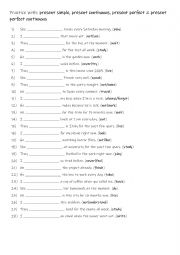
|
B1 -B2 Practice with present simple, present continuous, present perfect & present perfect continuous
Learning the present simple, present continuous, present perfect, and present perfect continuous tenses is crucial for students as these tenses allow them to express a wide range of meanings related to actions and states in the present. The present simple is used for routines and facts, the present continuous for actions happening now, the present ...
Level: intermediate
Age: 9-100
Type:
Downloads: 134
|
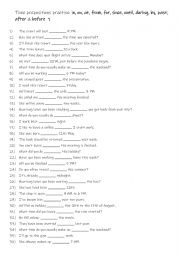
|
A2-B1 Time prepositions practise in, on, at, from, for, since, until, during, by, past, after & before 1
Learning time prepositions like in, on, at, from, for, since, until, during, by, past, and after is important for students because they are essential for expressing time relationships clearly and accurately. These prepositions help students talk about when things happen, how long actions last, and their sequence in time. Mastering them allows stude...
Level: intermediate
Age: 8-100
Type:
Downloads: 105
|
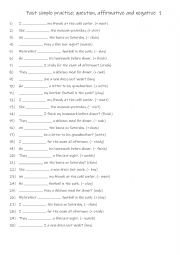
|
A1 Past simple practise with: question, affirmative and negative 1
Learning the past simple tense with questions, affirmative, and negative sentences is essential for students as it enables effective communication about past events. It provides a foundation for understanding grammar and constructing basic sentences, which is crucial for daily conversations. Mastering these forms ensures students can ask questions,...
Level: elementary
Age: 8-100
Type:
Downloads: 129
|
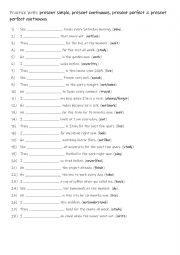
|
B1 -B2 Practice with present simple, present continuous, present perfect & present perfect continuous
Learning the present simple, present continuous, present perfect, and present perfect continuous tenses is crucial for students as these tenses allow them to express a wide range of meanings related to actions and states in the present. The present simple is used for routines and facts, the present continuous for actions happening now, the present ...
Level: intermediate
Age: 9-100
Type:
Downloads: 108
|
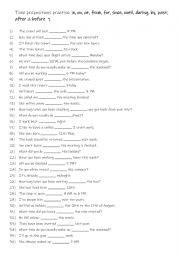
|
A2-B1 Time prepositions practise in, on, at, from, for, since, until, during, by, past, after & before 1
Learning time prepositions like in, on, at, from, for, since, until, during, by, past, and after is important for students because they are essential for expressing time relationships clearly and accurately. These prepositions help students talk about when things happen, how long actions last, and their sequence in time. Mastering them allows stude...
Level: intermediate
Age: 8-100
Type:
Downloads: 109
|
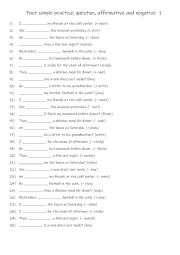
|
A1 Past simple practise with: question, affirmative and negative 1
Learning the past simple tense with questions, affirmative, and negative sentences is essential for students as it enables effective communication about past events. It provides a foundation for understanding grammar and constructing basic sentences, which is crucial for daily conversations. Mastering these forms ensures students can ask questions,...
Level: elementary
Age: 8-100
Type:
Downloads: 102
|
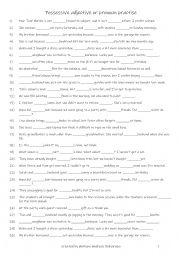
|
A1+-A2 Possessive adjectives & possessive pronouns practise 2
Learning possessive adjectives and possessive pronouns is essential for expressing ownership and relationships clearly and naturally in English. Possessive adjectives (like my, your, his, her) are used before nouns to show who something belongs to, while possessive pronouns (like mine, yours, his, hers) stand alone and replace nouns, avoiding repet...
Level: elementary
Age: 8-100
Type:
Downloads: 105
|
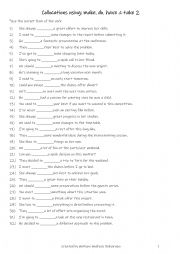
|
A2-B1 Collocations using make, do, have & take 2
Learning collocations with make, do, have, and take is important because they help you speak and write more naturally and fluently in English. These verbs often pair with specific nouns or phrases, and using them correctly improves your communication. For example, "make a decision", "do homework", "have a conversation", and "take a break" are commo...
Level: intermediate
Age: 8-100
Type:
Downloads: 114
|
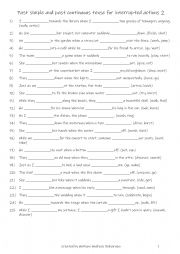
|
A1+-A2 Past simple and past continuous tense for interrupted actions 2
Learning the past simple and past continuous tenses for interrupted actions is essential because they help students describe events that were happening in the past when something else occurred. The past continuous is used to show the action that was in progress at a specific time in the past, while the past simple is used to describe the action tha...
Level: elementary
Age: 8-100
Type:
Downloads: 104
|
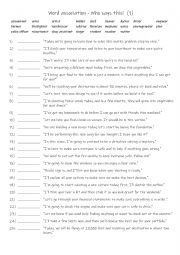
|
A2-B1 Word association with jobs -Who says this! (1)
Learning vocabulary for professions like accountant, chef, teacher, and nurse is valuable because it helps people identify roles, understand career-specific responsibilities, and communicate effectively in different situations. Recognising job titles and what each profession involves supports clearer communication in daily life and improves underst...
Level: elementary
Age: 8-100
Type:
Downloads: 123
|
|
|
|
|












